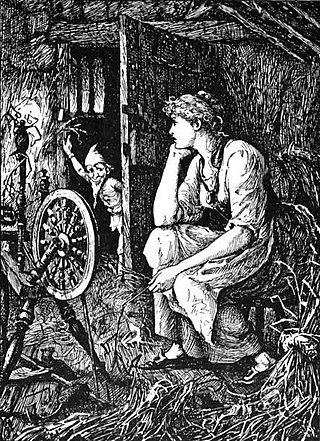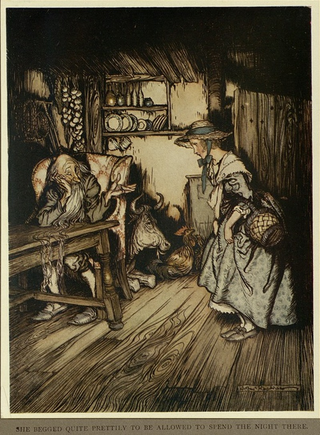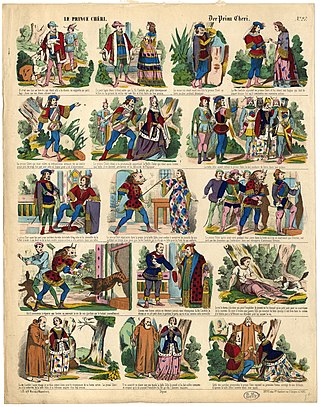
In mythology, folklore and speculative fiction, shapeshifting is the ability to physically transform oneself through unnatural means. The idea of shapeshifting is found in the oldest forms of totemism and shamanism, as well as the oldest existent literature and epic poems such as the Epic of Gilgamesh and the Iliad. The concept remains a common literary device in modern fantasy, children's literature and popular culture. Examples of shapeshifters are vampires and werewolves.

The Langs' Fairy Books are a series of 25 collections of true and fictional stories for children published between 1889 and 1913 by Andrew Lang and his wife, Leonora Blanche Alleyne. The best known books of the series are the 12 collections of fairy tales also known as Andrew Lang's "Coloured" Fairy Books or Andrew Lang's Fairy Books of Many Colors. In all, the volumes feature 798 stories, besides the 153 poems in The Blue Poetry Book.
Farmer Weathersky is a Norwegian fairy tale collected by Peter Chr. Asbjørnsen and Jørgen Moe in Norske Folkeeventyr.
"The Thief and His Master" is a German fairy tale collected by the Brothers Grimm in Grimm's Fairy Tales as tale number 68. In the first edition there was another fairy tale at place 68. The name of the fairy tale is "Von dem Sommer- und Wintergarten".
"Nix Nought Nothing" is a fairy tale included in Joseph Jacobs's anthology, English Fairy Tales (1898). It is a translation of the Scottish tale "Nicht Nought Nothing", originally collected by Andrew Lang from an old woman in Morayshire, Scotland.

"The Hut in the Forest" is a German fairy tale collected by the Brothers Grimm. Andrew Lang included it in The Pink Fairy Book (1897). It is Aarne-Thompson type 431.
Ruth Manning-Sanders was an English poet and author born in Wales, known for a series of children's books for which she collected and related fairy tales worldwide. She published over 90 books in her lifetime
The Bird 'Grip' is a Swedish fairy tale. Andrew Lang included it in The Pink Fairy Book. It is Aarne-Thompson type 550, the quest for the golden bird/firebird; other tales of this type include The Golden Bird, The Greek Princess and the Young Gardener, How Ian Direach got the Blue Falcon, The Nunda, Eater of People, and Tsarevitch Ivan, the Fire Bird and the Gray Wolf.
The Grateful Prince is an Estonian fairy tale. The tale is classified in the Aarne-Thompson-Uther Index as ATU 313, "The Magic Flight".
King Kojata or The Unlooked for Prince or Prince Unexpected is a Slavonic fairy tale, of Polish origin. Louis Léger remarked that its source was "one of the most important collections of Polish literature".
Fortunée or Felicia and the Pot of Pinks is a French literary fairy tale, written by Madame d'Aulnoy. Andrew Lang included it in The Blue Fairy Book.
The Magic Book is a Danish fairy tale collected by Evald Tang Kristensen in Eventyr fra Jylland Andrew Lang included it in The Orange Fairy Book, listing it as translated by Mrs. Skavgaard-Pedersen.
Maestro Lattantio and His Apprentice Dionigi is an Italian literary fairy tale written by Giovanni Francesco Straparola in The Facetious Nights of Straparola.

An Ordinary Miracle is a Soviet 1978 romantic fantasy musical film directed by Mark Zakharov and based on a play by Evgeny Schwartz. This is the second adaptation of the play; the first one was filmed in 1964 by Erast Garin.

Prince Darling is a French literary fairy tale written by Madame Jeanne-Marie Leprince de Beaumont.

Tales of the Night is a 2011 French computer silhouette animation feature film directed by Michel Ocelot. It is a compilation movie for movie theaters of five episodes of Dragons et Princesses in stereoscopic 3D and one additional, until then unseen story, "The Girl-Doe and the Architect's Son", for a total of six. It premièred in competition for the Golden Bear at the 61st Berlin International Film Festival on February 13, 2011 before its general release in France by StudioCanal on July 20.

The Land of Stories is a series of children's fiction, adventure, and fantasy books written by American author, actor, and singer Chris Colfer. The first book, The Wishing Spell, was released on July 17, 2012, with the sixth and final book published in July 2017. Colfer started plans for a prequel series in 2016, and has since published three books in this series, beginning with A Tale of Magic... in 2019.

Ileana Simziana or Ileana Sînziana is a Romanian fairy tale collected and written down by Petre Ispirescu between 1872 and 1886. It tells the story of an unnamed youngest daughter of an emperor, who dresses up as a man, goes to serve another emperor and rescues the titular princess Ileana. During a quest of obtaining the Holy Water she is hit by a curse of a monk that causes her to transform into a man - Făt-Frumos, who marries Ileana in the happy ending.







